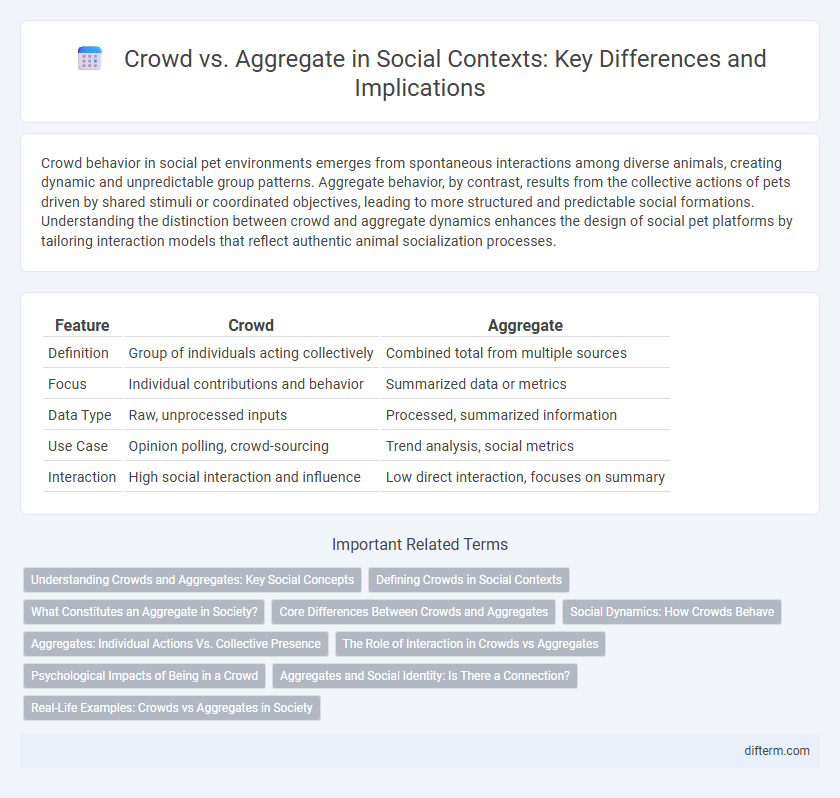Crowd behavior in social pet environments emerges from spontaneous interactions among diverse animals, creating dynamic and unpredictable group patterns. Aggregate behavior, by contrast, results from the collective actions of pets driven by shared stimuli or coordinated objectives, leading to more structured and predictable social formations. Understanding the distinction between crowd and aggregate dynamics enhances the design of social pet platforms by tailoring interaction models that reflect authentic animal socialization processes.
Table of Comparison
| Feature | Crowd | Aggregate |
|---|---|---|
| Definition | Group of individuals acting collectively | Combined total from multiple sources |
| Focus | Individual contributions and behavior | Summarized data or metrics |
| Data Type | Raw, unprocessed inputs | Processed, summarized information |
| Use Case | Opinion polling, crowd-sourcing | Trend analysis, social metrics |
| Interaction | High social interaction and influence | Low direct interaction, focuses on summary |
Understanding Crowds and Aggregates: Key Social Concepts
Crowds consist of individuals temporarily gathered with a shared focus or emotion, often exhibiting collective behavior and social influence. Aggregates refer to people physically co-present but without significant interaction or common purpose, lacking coordinated behavior. Understanding these distinctions highlights how social dynamics shape group identity, decision-making, and collective action in diverse situations.
Defining Crowds in Social Contexts
Crowds in social contexts refer to groups of individuals who gather temporarily in a shared space, often driven by a common purpose or event, influencing collective behavior and social dynamics. Unlike aggregates, which are merely collections of people without interaction or shared intent, crowds exhibit heightened emotional intensity and social cohesion. Understanding these distinctions helps in analyzing crowd behavior, social influence, and the impact on public order and communication.
What Constitutes an Aggregate in Society?
An aggregate in society consists of individuals who are grouped together based on a shared physical location or common characteristic but lack meaningful social interaction or a sense of identity. Unlike a crowd, which involves spontaneous, intense interaction among people with a common purpose, an aggregate remains a collection of separate, unconnected members. Examples include people waiting at a bus stop or shoppers in a mall where proximity does not create social bonds or collective behavior.
Core Differences Between Crowds and Aggregates
Crowds consist of individuals temporarily gathered with shared emotions or goals, displaying collective behavior and social interaction, whereas aggregates are simply collections of people in the same location without significant interaction or common purpose. The core difference lies in the presence of social cohesion and dynamic interaction within crowds, in contrast to the random, unconnected nature of aggregates. Understanding this distinction helps in analyzing social behaviors, crowd psychology, and public safety management.
Social Dynamics: How Crowds Behave
Crowds exhibit complex social dynamics characterized by collective behavior emerging from individual interactions, often leading to amplified emotions and rapid decision-making. Unlike simple aggregates, which are mere collections of individuals without interaction, crowds develop shared norms and influence mechanisms that can drive coordinated actions. Understanding these dynamics is crucial for managing events, public safety, and predicting crowd behavior in social contexts.
Aggregates: Individual Actions Vs. Collective Presence
Aggregates represent the sum of individual actions that occur within a shared space without coordinated interaction, highlighting how personal behaviors collectively shape social environments. Unlike crowds, which involve collective presence driven by shared purpose or emotional connection, aggregates are characterized by the independent and simultaneous activities of individuals. Understanding aggregates is crucial for analyzing patterns in public spaces, urban planning, and social dynamics where individual autonomy intersects with group phenomena.
The Role of Interaction in Crowds vs Aggregates
Interaction plays a crucial role in differentiating crowds from aggregates, where crowds exhibit dynamic behaviors driven by shared emotions, intentions, and communication among individuals. Aggregates, in contrast, are simply collections of people in the same place without meaningful interaction or common purpose. This distinction highlights how social bonds and collective identity emerge through communication and mutual influence within crowds.
Psychological Impacts of Being in a Crowd
Being in a crowd often triggers heightened emotional arousal and a sense of anonymity, leading to changes in individual behavior known as deindividuation. This psychological impact can result in reduced self-awareness, increased impulsivity, and greater susceptibility to social influence or panic. Understanding the distinctions between crowd dynamics and aggregate gatherings is essential for addressing group behavior and managing social situations effectively.
Aggregates and Social Identity: Is There a Connection?
Aggregates consist of individuals temporarily sharing a physical space without significant interaction, contrasting with crowds where social identity and group cohesion emerge. Social identity theory suggests that the formation of a collective self-concept is minimal in aggregates due to the lack of shared goals or membership, limiting the development of unified group behavior. Research highlights that aggregates rarely foster strong social bonds or collective actions, underscoring their distinction from psychologically cohesive crowds.
Real-Life Examples: Crowds vs Aggregates in Society
Crowds consist of individuals temporarily gathered with a common focus, such as fans at a concert or protesters at a rally, exhibiting collective behavior and emotional intensity. Aggregates are groups of people who share a physical space but lack a common purpose, like shoppers in a mall or commuters at a train station, characterized by individualistic behavior. Understanding the distinction between crowds and aggregates is crucial for designing effective public safety measures and urban planning strategies.
crowd vs aggregate Infographic

 difterm.com
difterm.com